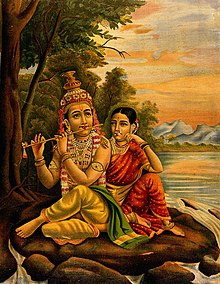
| Part of a series on |
| Hinduism |
|---|
 |
Ānanda (Sanskrit: आनन्द) literally means bliss or happiness. In the Hindu Vedas, Upanishads and Bhagavad gita, ānanda signifies eternal bliss which accompanies the ending of the rebirth cycle. Those who renounce the fruits of their actions and submit themselves completely to the divine will, arrive at the final termination of the cyclical life process (saṃsāra) to enjoy eternal bliss (ānanda) in perfect union with the godhead. The tradition of seeking union with God through loving commitment is referred to as bhakti, or devotion.[1]
Etymology
Ānanda is a Sanskrit word regarded as a verbal noun nanda prefixed with ā. ā indicates the place where the verbal action occurs; for example, āsrama, where one toils, ārama, where one enjoys oneself, ākara, where things are scattered, etc. The word ānanda thus implies a locus, that in which one finds bliss, be it a son, the fulfillment of a wish, the knowledge of brahman, or the atman,. Ānanda is not just a free-floating unfocused bliss, it has an implied object.[2]
Different descriptions of Ānanda in Hindu philosophy
Shatapatha Brahmana
In the Shatapatha Brahmana (10.3.5.13), ānanda is defined as the knowledge of Brahman, which transforms a person into a divine being. Verse 10.3.5.14 emphasizes that ānanda, when understood as knowledge, is connected with the fulfillment of wishes, echoing a verse from the Rigveda (9.113.11), where attaining all desires (ānanda) is a prerequisite for immortality.[3]
Taittiriya Upanishad
Perhaps the most comprehensive treatise on 'ānanda' is to be found in the Ananda Valli of Taittiriya Upanishad, where a gradient of pleasures, happiness, and joys is delineated and distinguished from the "ultimate bliss" (ब्रह्मानंद)- absorption in Self-knowledge, a state of non-duality between object and subject.[4] This essential description of 'ānanda' as an aspect of the non-dual Brahman is further affirmed by Adi Shankara's commentary[5] on the Brahma Sutras, Chapter 1, Section 1, Shloka 12, आनन्दमयोऽभ्यासात्.
Taittiriya Upanishad verses 2.3.3-9 describes the self (atman) as self-luminous and covered by five sheaths, with bliss (ānanda) as the innermost and subtlest layer.[6]
Vedanta
According to the Vedanta school of Hindu philosophy, ananda is that state of sublime delight when the jiva becomes free from all sins, all doubts, all desires, all actions, all pains, all sufferings and also from all physical and mental ordinary pleasures. Having become established in Brahman it becomes jivanmukta (a being free from the cycle of rebirth).[7] The Upanishads repeatedly use the word Ānanda to denote Brahman, the innermost Self, the Blissful One, which, unlike the individual self, has no real attachments.
Dvaita vedanta
Based on a reading of the Bhagavad Gita, Dvaita vedanta interprets ananda as happiness derived via good thoughts and good deeds that depend on the state and on the control of the mind. Through evenness of temper and mind, the state of supreme bliss is reached in all aspects of one’s life.[8]
Vishishtadvaita vedanta
According to Ramanujacharya of the Vishishtadvaita vedanta school, true happiness arises through divine grace, which becomes available through the surrender of one's ego to the Divine. The practice of prapatti (unreserved resignation to the Lord) allows the soul's bondage to the delusions of independence to be transcended in the supreme bliss of devotion to the Divine.[9]
Swami Vivekananda
According to Swami Vivekananda, different meanings of ānanda and different ways of achieving it are present in Hindu philosophy because humans differ from each other, and each must choose the most appropriate path for him or herself.[10]
Sri Aurobindo
According to Sri Aurobindo, happiness is the natural state of humanity, as he mentions in his book The Life Divine he informs about it as delight of existence. However, mankind develops dualities of pain and pleasure. Aurobindo goes on to say that the concepts of pain and suffering are due to habits developed over time by the mind, which treats success, honour and victory as pleasant things and defeat, failure, misfortune as unpleasant things.[11]
Sri Ramana Maharshi
According to Ramana Maharshi, happiness is within and can be known only through discovering one's true self. He proposes that ananda can be attained by inner enquiry, using the thought "Who am I?"[12]
Ways of achieving ānanda
Within the various schools of Hindu thought, there are different paths and ways of achieving Happiness. The main four paths are Bhakti yoga, Jnana yoga, Karma yoga and Raja yoga.[10]
See also
References
- ^ J. Bruce Long; Laurie Louise Patton (2005), "LIFE", Encyclopedia of Religion, vol. 8 (2nd ed.), Thomson Gale, pp. 5447–5448
- ^ van Buitenen, J. A. B. (1979). ""Ānanda", or All Desires Fulfilled". History of Religions. 19 (1): 32. ISSN 0018-2710. JSTOR 1062420.
- ^ van Buitenen, J. A. B. (1979). ""Ānanda", or All Desires Fulfilled". History of Religions. 19 (1): 27–36. ISSN 0018-2710.
- ^ "Ananda Mimamsa – The Essence of the Aitareya and Taittiriya Upanishads – Chapter 5". www.swami-krishnananda.org. Archived from the original on 2021-09-29. Retrieved 2021-09-29.
- ^ "Archived copy" (PDF). Archived (PDF) from the original on 2021-09-29. Retrieved 2021-09-29.
{{cite web}}: CS1 maint: archived copy as title (link) - ^ Long, Jeffery D.; Sherma, Rita D.; Jain, Pankaj; Khanna, Madhu, eds. (2022). Hinduism and Tribal Religions. Encyclopedia of Indian Religions. Dordrecht: Springer Netherlands. p. 69. doi:10.1007/978-94-024-1188-1. ISBN 978-94-024-1187-4.
- ^ Vedanta-sara of Sadananda. Translated and commented by Swami Nikhalananda. Published by Advaita Ashrama, Kolkata. Verse VI.217 p.117 http://www.estudantedavedanta.net/Vedantasara-Nikhilananda.pdf Archived 2013-09-01 at the Wayback Machine
- ^ Dvaita Vedānta 1975, T. P. Ramachandran
- ^ Ramanuja; Swami Adidevanand. Ramanuja Gita Bhashya. Mylapore, Madras: Ramakrishna Math. pp. 11–12.
- ^ a b Pathways to Joy: The Master Vivekananda on the Four Yoga Paths to God 2006 , Swami Vivekananda
- ^ The Life divine 2005, and he calls his way of yoga as Integral yoga p. 98-108
- ^ Talks With Ramana Maharshi: On Realizing Abiding Peace and Happiness 2000, Ramana Maharshi














You must be logged in to post a comment.